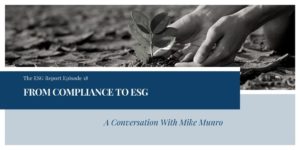
Mike Munro has worked with global companies such as Dell Chemical, Baker Hughes, and Transocean, for more than 30 years. His last position before founding Global Compliance Management and Response (GCMR) was as Chief Compliance Officer at Odebrecht Engineering and Construction in Brazil. He joins Tom Fox on this week’s episode of the ESG Report to discuss GCMR, as well as moving from compliance to ESG.
ESG Is More Than Anti-Corruption
Mike believes that compliance is about more than just anti-corruption issues. “It was clear that the elements and the focus of compliance programs and efforts are really applicable to a much broader area,” he tells Tom. After his work at Odebrecht ended, he decided to establish his own company to “bring what all of us have learned over the years regarding compliance programs and their value and the things that they’re focused on, and make sure that they can also bring value to other areas. And so that brought me into ESG because clearly, that is an area that does need a lot of help, a lot of work.”
From Compliance to ESG
Tom asks Mike, “What are some of the skills you see that a compliance professional has, which really lends itself to either leading or being a part of the leadership team for a corporate ESG effort?” Mike responds that one such skill is the ability to work cross-functionally. “A company really has to bring in many different stakeholders within the company, make sure that all those stakeholders understand what the issues are, understand what they need to do, understand their role in compliance. And that is exactly what is needed in ESG,” he tells listeners. ESG covers many dimensions and requires people across the company to work together, so the compliance officer – who already has expertise in leading cross-functional teams – is well suited to take the lead. He and Tom discuss how compliance and ESG overlap and that ESG will evolve in the same way the compliance function did. “All of those things that happened with compliance programs early on,” Mike remarks, “where you started with a very basic program, and then you moved to training and then you moved to tracking and then you moved to running investigations. Those similar things need to happen with ESG.”
The Culture of Safety
Many companies are already doing good things – particularly in safety and environmental compliance – but they don’t have a formalized ESG program, so they do not track or communicate what they’re doing, which means that they don’t get credit for their efforts. An ESG program ‘allows for more of the positive story to be told,” Mike comments. Tom remarks on the culture of safety in energy companies. Everyone knows why the safety rules are important, and they follow them religiously. He and Mike agree that this is the same direction compliance and ESG need to take.
GCMR and the Future of ESG
GCMR has brought together a global team of experts who can address ESG issues with the local context. “We are just absolutely focused on making sure when we provide services to a client that we are first and foremost, stressing that local issues have to be understood,” Mike points out. Tom asks whether Mike believes regulators or stakeholders will drive the evolution of ESG. It will be the financiers, Mike responds. He comments on the push in the EU for sustainability elements to have the same financial standards and the implications for companies’ financial reporting.
ESG in Acquisitions
GCMR has compiled a simple list of key ESG items. This is how they help companies quickly assess potential acquisitions. “Part of the value of ESG reporting is being able to tell the whole story, but I truly believe that sometimes people make this more complicated than it has to be,” Mike comments.
Resources
Mike Munro on LinkedIn
Global Compliance Management and Response





